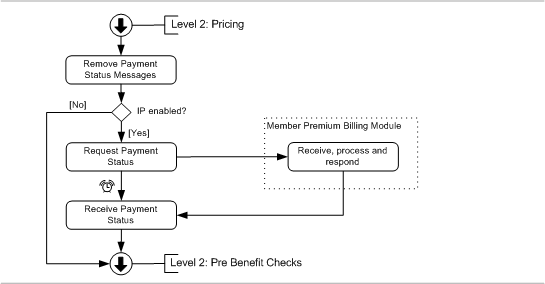Gathering Payment Status Data
In this step Claims calls out for information directly related to the distinct serviced person’s or object’s payment status for its enrollment. The response is persisted in the form of claim line messages. These messages can be used to automatically deny or pend the claim, later on in the processing flow. Note that locked claim lines and replaced claim lines are ignored during this step.

Remove Payment Status Messages
First, any existing claim line messages that have been returned by a previous payment status call out are removed.
Request Payment Status Data
This integration point can be disabled through technical configuration of Claims. If disabled, the claim skips ahead towards the level 2: Pre-Benefits Checks flow.
For each distinct serviced person or object specified on a claim line, a payment status request is sent. The request contains the following attributes and the list of the policy products.
-
The start date of the period for which payment status information is requested.
-
The end date of the period for which payment status information is requested.
-
The serviced insurable entity
The list of the policy products is the list returned on the enrollment response.
The start and end date in the request are equal to the start and end date stored on the claim. Note that the start and end date on the claim represent the time span that bounds all service dates on the pertaining claim lines.
The payment status request is not sent out (for any person or object) if a fatal message of origin SANITY CHECKS or ENROLLMENT exists that is attached to the claim. The payment status request is not sent out for a specific person or object, in the event that all claim lines for that person or object have a product independent fatal message of origin SANITY CHECKS or ENROLLMENT (either on the line or bill). The payment status request is not sent out for a specific person or object, if no product enrollments are stored for it.
Receive Payment Status Data
Once all the requests for a single claim are sent out, the claim is held in a status that signifies that it is awaiting a payment status response. At this point, a waiting time timer starts. The claim retains its status until one the following occurs:
-
A response message is received for each of the sent out request messages.
-
The waiting time expires.
In the event that the response time window expires before all responses have been received, the claim automatically pends with a technical error. These claims are accessible and can be restarted in the "View Technical Errors" page once the interface has been restored.
In the event that a response message has been received for each of the sent out request messages, the content of these messages is validated. The following situations will result in a fatal message on the claim line(s) that specify the requested serviced person or object:
-
The product code is unknown
-
The message code is unknown.
The following error messages may be attached as a result of one of the situations described above. A message is attached to any claim line (within the claim that triggered the payment status request) that specifies the requested serviced person or object:
| Code | Sev | Text |
|---|---|---|
CLA-IP-PMSS-001 |
Fatal |
The product code {code} is unknown. |
CLA-IP-PMSS-002 |
Fatal |
The message code {code} is unknown. |
If no fatal messages are attached, then upon processing the response message, the product specific messages returned in the payment status response are attached to the applicable claim lines on the condition that the start/end date of the encapsulating <product> element overlaps with the start/end date of the claim line.
Note that it is only after the benefits have been applied, that is, when it is known which product(s) actually provide(s) the benefit, that it is determined which of those product specific messages are relevant and which can be discarded.
Messages that are specific to a product not in the list of policy products, are not stored.